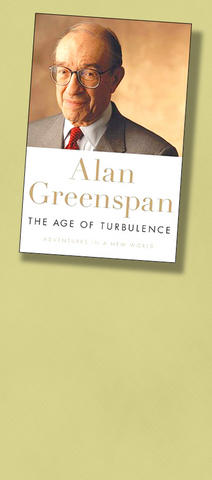In 1944 a draft board in downtown Manhattan rejected Alan Greenspan, then a recent high school graduate, for military service because he had a spot on his lung that looked like it might be tuberculosis. So Greenspan, suddenly without a plan for the future, auditioned to play clarinet for the trumpeter Henry Jerome's traveling big band.
He got the job, but he was never a star. He was a sideman rather than a soloist. Among his fellow musicians he became known as the band's resident intellectual, the clarinetist who could also fill out his bandmates' income tax forms for them. Between sets, when they disappeared into the green room - "which would quickly fill with the smell of tobacco and pot," Greenspan recalls - he read books about business.
The pattern repeated itself, albeit in a more sober form, after the war ended and he began studying economics at New York University. Many of his classmates were swept up by grand questions relating to the new economic order, but Greenspan was more interested in numbers and equations. "I still had the sideman psychology," he writes in his memoir, The Age of Turbulence. "I preferred to focus on technical challenges and did not have a macro view."

His macro view wouldn't come until the 1950s, when his first wife introduced him to Ayn Rand's New York salon. Rand - whom he calls "quite plain to look at" but "a stabilizing force in my life" - pushed him to think beyond mathematics and helped turn him into a libertarian.
By the time former US president Ronald Reagan named Greenspan to run the Federal Reserve in 1987, he had already a lived a full, fascinating, Zelig-like life. For years he was the quietly influential man off to the side. With his book he finally lets us know what he was thinking.
For a memoir from such a high-profile figure, it is surprisingly frank. Large parts of the book are downright entertaining. Its biggest failing - the reason it isn't a great memoir - is Greenspan's reluctance to be as forthright and penetrating about himself as he is about others.
Born in 1926, he was raised in Washington Heights, the only son of parents who soon divorced. He attended George Washington High School a few years behind Henry Kissinger (and a few decades before the baseball stars Rod Carew and Manny Ramirez, a historical oddity that Greenspan, who still remembers Joe DiMaggio's 1936 batting average, probably appreciates). Before joining the Jerome big band, he played in the same informal ensemble as Stan Getz. At Columbia University, Arthur Burns, himself a future chairman of the Fed, became Greenspan's graduate-school adviser.
Like his father, a stockbroker, Greenspan eventually made his way to Wall Street, where he ran a consulting business that forecast the economy. He was doing quite nicely there when Martin Anderson, another Rand acolyte, asked if Greenspan wanted to join former US president Richard Nixon's 1968 presidential campaign.
Except for former US president Jimmy Carter, Greenspan has worked with every president since 1969, and the book offers a fairly blunt critique of each. Gerald Ford, who's portrayed as an unusually decent politician, clearly ranks first. "He always understood what he knew and what he didn't know," Greenspan writes.
Despite their ideological differences, former US president Bill Clinton seems to place second, thanks to his "consistent, disciplined focus on long-term economic growth." At one point, with urging from Newt Gingrich, the House speaker, Greenspan called Rush Limbaugh to argue for the Clinton administration's Mexican loan guarantees. Greenspan even shares some of the credit for his signature insight - recognizing early on that technology was transforming the economy - with Clinton.
Nixon, Reagan and former US president George H.W. Bush each receives a mix of praise and criticism. Only the US President George W. Bush goes without receiving credit for a single significant accomplishment.
The Age of Turbulence is really two books, one of which I suspect Greenspan preferred writing and one of which he understood his audience would prefer reading. The second half - the typically Greenspan half - is a series of meditations on economic issues, like income inequality and the rise of China.
The first 250-odd pages are a standard autobiography, and Greenspan confesses in the acknowledgments that learning to write in the first person was a struggle. For all of the book's candor, this is a struggle he does not quite win. This first half of the book is utterly readable, but it lacks a narrative core. It's telling that the book opens on Sept. 11, 2001, with Greenspan on a plane flying home from Switzerland that gets rerouted. This is supposed to serve as drama.
Greenspan also doesn't really let readers inside his life. He laments that Nixon's televised announcement of price controls in 1971 preempted Bonanza - "a show I loved to watch" - and he calls his wife, Andrea Mitchell, "very beautiful." But he does not easily admit error. He does not even confess to having his own ambitions. He seems to want people to believe that he accepted his fantastic ascent with reluctance.
Yet, perhaps accidentally, he has still managed to create a lasting image of himself. He never seems happier than when pouring over economic indicators that allow him to predict everything from the 1958 steel recession to the 1990s boom. "My early training was to immerse myself in extensive detail in the workings of some small part of the world and to infer from that detail the way that segment of the world behaves. That is the process I have applied throughout my career," he writes.
He lacks the same sure footing when confronting the great political issues, and even the economic ones, of the last few decades. He provided the critically influential voice in support of the current administration's tax cuts, for instance, but he now disowns them. He worries that the backlash to globalization could create a "truly serious economic crisis," but his proposed remedies - like higher pay for math teachers - don't seem up to the task.
Despite Rand's tutoring he never quite escapes the sideman's psychology. Now, there should be no shame in that. Greenspan may have had a better feel for the ups and downs of the postwar American economy than anyone else, and he put his talents to good use as a central banker. The question that lingers is why the rest of us allowed him to be treated as something much more.

The 1990s were a turbulent time for the Chinese Nationalist Party’s (KMT) patronage factions. For a look at how they formed, check out the March 2 “Deep Dives.” In the boom years of the 1980s and 1990s the factions amassed fortunes from corruption, access to the levers of local government and prime access to property. They also moved into industries like construction and the gravel business, devastating river ecosystems while the governments they controlled looked the other way. By this period, the factions had largely carved out geographical feifdoms in the local jurisdictions the national KMT restrained them to. For example,

The remains of this Japanese-era trail designed to protect the camphor industry make for a scenic day-hike, a fascinating overnight hike or a challenging multi-day adventure Maolin District (茂林) in Kaohsiung is well known for beautiful roadside scenery, waterfalls, the annual butterfly migration and indigenous culture. A lesser known but worthwhile destination here lies along the very top of the valley: the Liugui Security Path (六龜警備道). This relic of the Japanese era once isolated the Maolin valley from the outside world but now serves to draw tourists in. The path originally ran for about 50km, but not all of this trail is still easily walkable. The nicest section for a simple day hike is the heavily trafficked southern section above Maolin and Wanshan (萬山) villages. Remains of

With over 100 works on display, this is Louise Bourgeois’ first solo show in Taiwan. Visitors are invited to traverse her world of love and hate, vengeance and acceptance, trauma and reconciliation. Dominating the entrance, the nine-foot-tall Crouching Spider (2003) greets visitors. The creature looms behind the glass facade, symbolic protector and gatekeeper to the intimate journey ahead. Bourgeois, best known for her giant spider sculptures, is one of the most influential artist of the twentieth century. Blending vulnerability and defiance through themes of sexuality, trauma and identity, her work reshaped the landscape of contemporary art with fearless honesty. “People are influenced by

Ten years ago, English National Ballet (ENB) premiered Akram Khan’s reimagining of Giselle. It quickly became recognized as a 21st-century masterpiece. Next month, local audiences get their chance to experience it when the company embark on a three-week tour of Taiwan. Former ENB artistic director Tamara Rojo, who commissioned the ballet, believes firmly that if ballet is to remain alive, works have to be revisited and made relevant to audiences of today. Even so, Khan was a bold choice of choreographer. While one of Britain’s foremost choreographers, he had never previously tackled a reimagining of a classical ballet, so Giselle was